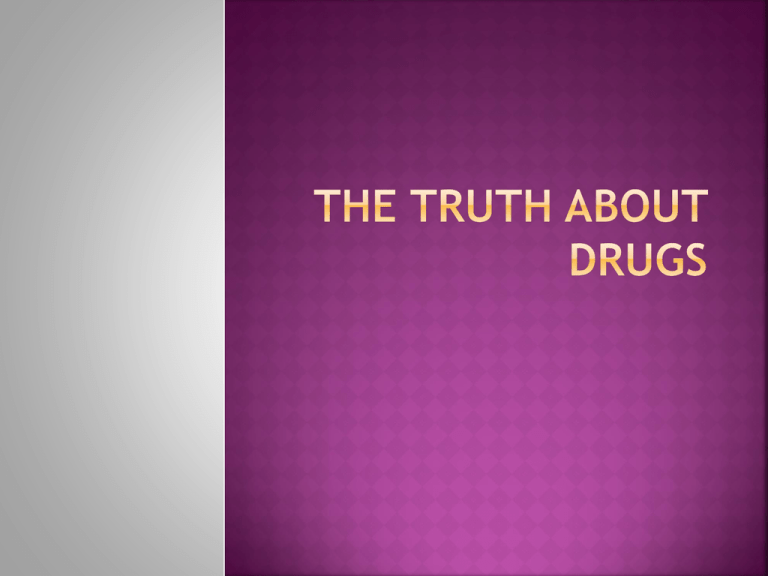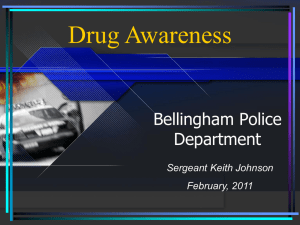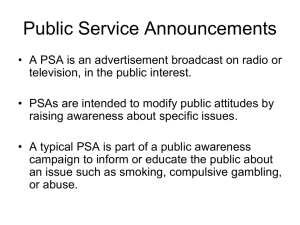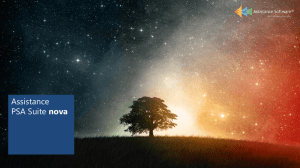
1.
2.
3.
4.
5.
6.
7.
8.
9.
What is a drug?
Are Drugs Dangerous? Yes or No
If you answered “yes” to #2 explain why you think
so.
When you take a drug, does it affect your health? If
yes, how?
When you take a drug, does it affect your ability to
learn? If yes, how?
What does “drug addiction” mean?
How does a person become addicted to a drug?
If a person becomes addicted to a drug, how does it
affect his or her life?
If you knew the facts about drugs and what they do
to you, how would this help you?
PSA:
They Said/They Lied
Discussion: Give your view and examples of
lies or statements you have heard about
drugs.
Documentary “The Truth About Drugs”
Your task is to try and identify at least 2
statements about drugs that you already know
and 2 statements about drugs you don’t already
know.
Discussion
“Do you have to experience everything yourself
in order to decide whether you want to get into
something, or can you learn from other people’s
experiences to make better choices/”
Activity
Think of 1 question you have about drugs and
write that question on a separate piece of paper.
1.
2.
3.
What do you think is the most important
information presented in this chapter of
the documentary? Why?
If you were asked to write a short
description of this chapter of the
documentary, what would you say?
What do you think you can learn from other
people’s experiences with drugs?
**TURN IN HOMEWORK FROM LESSON
1
Today’s
focus: Societies drug problem
What does “culture” mean?
The beliefs and activities that are common to
members of a group. Includes ideas that people
have about art, religion, family, and government,
their ideas about what is important or valuable,
how people should act and what people like to
do for fun or entertainment.
What
do you think “drug culture” means?
Refers not only to the lifestyles of people who
abuse drugs and the modes of dress and behavior
common to abusers of different types of drugs,
but also refers to the degree to which drugs have
invaded so many aspects of our society and have
influenced our culture in fundamental ways.
Watch
PSA’s:
“E”; “Party All Night”; “Love Lost”; “Medicine
Chest”; “Focus”
Based
on your own experience, what are
some examples of ideas or actions that are
part of the drug culture?
Center
for Disease Control
An agency of the U.S. Government, with headquarters and
main laboratories in Atlanta, Georgia. The CDC conducts
research into the origin and occurrence of diseases and
develops methods for their control and prevention.
Rush
The first surge in sensation felt when smoking or injecting a
drug, varying in length in length depending on the drug
Cocktail
A beverage or solution made up of various drugs.
How
does the problem of drug culture
directly or indirectly affect you or your
family or how could it affect you in the
future?
Examples
People who drive under the influence of drugs or
alcohol are posing a danger, not only to themselves,
but many others as well.
People who steal or commit other crimes to have
money to buy drugs make the community unsafe.
Create
a cartoon-type sketch that depicts
some aspect of the drug culture.
Clearly show a belief, idea or action that is part
of the drug culture.
**TURN IN HOMEWORK FROM LESSON
2
Write down some reasons why you think people
take drugs.
PSA’s
Watch “Popular”.
Discuss “do you think people take drugs to be cool?”
Watch “Best High”.
Discuss “do you think people take drugs to feel
better?”
Watch “Tripping”.
Discuss “do you think people take drugs to forget their
problems?”
Watch “One of The Guys”.
Discuss “do you think people take drugs to be accepted
by their friends?”
1.
2.
Give 2 examples of the following
statement, either from your own
experience or from one that you invent:
“The consequences of drug use are always
worse than the problem one is trying to
solve with them.
For each of the 2 examples you gave in
answer to question #1, describe something
that the person might have done to solve
the problem that he/she was trying to solve
with drugs.
“Just
Once”
“One
Hit”
“Stay
Up and Study”
“Sniffing”
Poison
A substance that causes illness, injury or death if
taken into the body or produced within the body.
Stimulant
A drug that increases immediate energy and
alertness but that is accompanied by increases in
blood pressure, heart rate and breathing.
Sedative
A medicine or drug that calms or makes one
sleep.
Drugs
are poisons
How much you take determines the effect.
Small
amount speeds you up (stimulant)
Greater amount slows you down (sedative)
Even greater amount can KILL!
Directly affect the mind
Distort perception
Actions may be odd, irrational, inappropriate, and
even destructive
Block off all sensations
Wipe out alertness and muddy’s one’s thinking.
Intended
to speed up, slow down, or change
something about how your body is working to
try and make it work better.
They are still drugs
If
Act as sedatives or stimulants
Too much can kill you!
used incorrectly they can be as dangerous
as illegal drugs.
Blur
memory, causing blank spots
Brain becomes a cloudy mess.
Drugs
make people feel slow and stupid
causing failures in life.
The more you fail, the tougher life becomes, and
the more drugs you want.
Drugs
destroy creativity.
Give a false sense of feeling
With each episode the plunge is lower and lower,
eventually destroying all creativity.
Which
of the PSA’s viewed today best shows
the effects of drugs you have been learning
about?
Write a short explanation of why you believe
so.
Grade will not be determined by which PSA
you choose, but by whether your explanation
shows you have understood the effects of the
drugs you learned about in this lesson.
PSA
“Gateway”
What did you learn from watching the PSA?
Documentary:
The Truth About Marijuana
Do you think marijuana use can lead to harder
drugs?
Bronchitis
An inflammation (irritation, swelling, painful condition) of the
bronchi, the two branches of the windpipe that carry the air
into the lungs.
Gateway Drug
A drug which when used may lead to the use of more addictive
substances.
High
Having a temporary false feeling of happiness, with reduced
physical and mental control, by use of alcohol or a drug.
Immune System
Consists of all the organs and processes in the body that
protect a person from illness and infection.
Laced
Added a small amount of a drug or alcohol to something.
Menstrual Cycle
Panic attack
A sudden overpowering feeling of fear or anxiety that
prevents somebody from functioning, often triggered
by a past or present source of anxiety.
Potency
In a nonpregnant woman, the discharge of blood and
other material from the lining of the uterus about
once a month.
The strength of something such as a drug or alcoholic
beverage.
Prenatal
Existing or happening during pregnancy but before
childbirth.
Resin
Respiratory tract
A semisolid substance that comes from the sap of
some plants and trees. It is used in varnishes, paints,
adhesives, inks and medicines
The passage formed by the mouth, nose, throat and
lungs, through which air passes during breathing.
Tolerance
The natural or developed ability to resist the effects
of the continued or increasing use of a drug. When
someone uses a drug or other substance over an
extended period, they are said to build up a
tolerance for the effects of the drug.
Dried
flowers, seeds, and leaves of the
Indian hemp plant.
Street names
Mary Jane, astro turf, bhang, dagga, dope,
ghanja, grass, hemp, home grown, J, pot, reefer,
weed, roach, and Texas Tea.
Hashish
Made from resins of the Indian hemp plant.
On average 6 times stronger than marijuana.
Cannabis
Refers to any drug that comes from the Indian
hemp plant.
Hallucinogen
Substance which distorts how the mind perceives
the world you live in.
THC
Chemical that causes the distortion
Amount in each batch varies, percentage has
increased drastically in recent years.
Smoked
as a cigarette (joint)
Mixed with food and eaten
Replace tobacco in cigars with marijuana
(blunt)
When smoking a joint, person feels effects
within minutes.
increased heart rate, lessened coordination and
balance.
“dreamy” unreal state of mind that peaks within
the first 30 minutes of taking.
Short term effects wear off in 2-3 hours.
Severe
impact on the smoker’s lungs
1 joint gives as much exposure to cancer
producing chemicals as 5 cigarettes.
Poorer
memory and mental aptitude than
non-users.
Animals given marijuana by researchers have
shown signs of structural damage to the
brain.
Sensory distortion
Panic
Anxiety
Poor coordination of
movement
Lowered reaction time
Increased heart rate and
risk of heart attack
Reduced resistance to
common illnesses.
Growth disorders
Increase of abnormally
structured cells in the
body.
Reduction of male sex
hormone
Reduced sexual capacity
Lack of motivation
Personality and mood
changes
Inability to understand
things clearly
Answer
1.
2.
3.
4.
5.
the following questions
Marijuana comes from a plant. True of False?
Can the use of marijuana lead to harder drugs?
What are some of the short-term effects of
marijuana?
What are some of the long-term effects of
marijuana?
What was the most important thing you learned
from this lesson and how do you plan to use
what you have learned?
Blackout
A temporary loss of consciousness, sight or memory.
Delirium Tremens
A psychotic condition typical of withdrawal in chronic
alcoholics, involving tremors, hallucinations, anxiety, and
disorientation.
Dependence
Having a physical or mental “need” to use a drug or other
substance regularly, despite the fact that it is likely to have a
damaging effect.
High Blood pressure
The heart must work harder to pump blood through the
arteries. If condition persists, damage to the heart and blood
vessels is likely.
Motor skills
Nerve cells
Dexterity and ease of coordination in the execution of body
motions.
Cells that are part of the nervous system and send messages to
and from the brain.
Toxicity
The state of being poisonous to somebody or something.
PSA
“One of The Guys”
Documentary:
The Truth About Alcohol
There is evidence of an early alcoholic drink in China
around 7000 B.C.
In India, an alcoholic beverage called sura, distilled
from rice, was in use between 3000 and 2000 B.C.
In the 16th Century alcohol (called “spirits”) was used
largely for medicinal purposes.
In 1920 the United States passed a law prohibiting the
manufacture, sale, import, and export of intoxicating
liquors. The illegal alcohol trade boomed and by 1933,
the prohibition of alcohol was cancelled.
Today an estimated 15 million Americans suffer from
alcoholism and 40% of all car accident deaths in the
U.S. involve alcohol.
It is a drug
Affects the mind
Classified as a depressant (slows down vital functions-resulting
in slurred speech, unsteady movement, and inability to react
quickly).
Reduces a person’s ability to think rationally and distorts
his/her judgment.
A beer or glass of wine creates a stimulant effect
“Loosens” you up.
Consume more than body can handle, experience the
depressant effect.
Start to feel “stupid” or lose coordination and control.
Overdose
Toxicity where body vomits the poison
Unconsciousness
Coma or death from severe toxic overdose.
Kinds of Alcohol
Ethyl (ethanol)
the only alcohol used in beverages, is produced by fermentation
(chemical process where yeast acts upon ingredients in the food,
creating alcohol) of grains and fruits.
Fermented drinks such as beer and wine contain from
2% to 20% alcohol.
Distilled drinks or liquor, contain 40% to 50% or more
alcohol.
Beer
Cider
Wine
Tequila
Rum
Brandy
Gin
Whiskey
Vodka
Liqueurs
2-6% alcohol
4-8% alcohol
8-20% alcohol
40% alcohol
40% or more
40% or more
40-47%
40-50%
40-50%
15-60%
Absorbed into the blood stream via small blood vessels
in walls of stomach and small intestine.
Within minutes, travels from stomach to the brain,
where it quickly produces its effects, slowing the action
of nerve cells.
20% is absorbed through the stomach, 80% is absorbed
through the small intestine.
The liver eliminates the alcohol from the blood through
a process called metabolizing
Liver can only metabolize a certain amount at a time, thus the
intensity of the effect on the body relates to amount of alcohol
consumed.
Cannot cope with alcohol the same way an adult can.
More harmful to teens because the brain is still
developing.
Drinking during this time can lead to lifelong damage in brain
function (memory, motor skills, and coordination).
Young people who begin drinking before age 15 are 4
times more likely to develop alcohol dependence than
those who begin drinking at age 21.
The practice of consuming large quantities of alcohol in
a single session.
Defined as 5 or more drinks at one time for a man, or 4 or
more drinks at one time for a woman.
90% of alcohol consumed by youth under the age of 21
in the United States is in the form of binge drinking.
Consists of 4 symptoms:
Craving
Loss of Control
inability to limit one’s drinking on any given occasion.
Physical Dependence
a strong need , or compulsion to drink.
withdrawal symptoms, such as nausea, sweating, shakiness, and anxiety,
occur when alcohol use is stopped after a period of heavy drinking.
Tolerance
The need to drink greater amounts of alcohol in order to get high.
Alcoholism is not a destination, but a progression, a
long road of deterioration in which life continuously
worsens.
Alcohol kills more teenagers than all other drugs
combined. It is a factor in the 3 leading causes of death
among 15-24 year olds: accidents, homicides and
suicides.
Youth who drink are 7.5 times more likely to use other
illegal drugs and 50 times more likely to use cocaine
than young people who never drink.
As many as 40% of violent crimes occur under the
influence of alcohol.
Short Term
Slurred speech
Drowsiness
Vomiting
Diarrhea
Upset stomach
Headaches
Unconsciousness
coma
Long Term
Unintentional injuries
Family problems
Alcohol poisoning
High blood pressure,
stroke, and other heart
related diseases.
Liver disease
Sexual problems
Ulcers
Cancer of the mouth and
throat
In
groups than no more than 4
Write a short skit that demonstrates how
someone’s life could be affected by alcohol.
Skit should be approximately 2-5 minutes
long.
Must demonstrate what your group has
learned about the effects of alcohol during
this lesson.
Skits need to be turned in when completed.
Delirium
Dilated
Unpredictable and unstable.
Euphoria
A state of being nervous and anxious and likely to lose control.
Erratic
Enlarged, usually describing the pupils of the eyes.
Edginess
A state marked by extreme restlessness, confusion, and
sometimes hallucinations, caused by fever, poisoning or brain
injury.
A feeling of great joy, excitement or well-being.
Hallucination
The perception of somebody or something that is not really
there, which is often a response to some drugs.
Hyper-excitability
Hyper-stimulation
Unusually stimulated (to cause physical activity in something
such as a nerve or an organ).
Methamphetamine
Hyper means excessive, unusually high. Hyper-excitability
means unusually high excitability (nervous and liable to
become quickly excited).
Highly addictive central nervous system stimulant; an illegal,
man-made synthetic drug in the same class as cocaine and
other powerful street drugs.
Narcotic
A drug affecting then CNS which can cause dizziness, euphoria,
loss of memory, lack of coordination and unconsciousness.
Respiratory failure
Sleep deprivation
Lessening or breakdown of the ability to breathe oxygen into
the body.
Not having or being prevented from having sufficient sleep.
Stroke
A sudden blockage or rupture of a blood vessel in the
brain resulting in, for example, loss of consciousness,
partial los of movement or loss of speech.
Tactile
Relating to or used for the sense of touch.
PSA:
Party all Night
Documentary:
The Truth About Cocaine
What
A
is Cocaine?
Deadly White Powder
Why
is Cocaine So Highly Addictive?
Effects
Short
Long
of Cocaine
Term Effects
Term Effects
Auditory
Blood vessel
Disturbances in a person’s emotional life. Including feeling of
sadness, hopelessness and worthless, complaints of physical pain,
and changes in appetite, sleep patterns and energy levels.
Reproductive damage
Any of the veins that transport blood through the body.
Mood disturbance
Related to hearing
Damage caused to the parts of the body having to do with the
production of children.
Tactile hallucinations
Tactile means having to do with the sense of touch. Tactile
hallucination is when someone experiences some perception
related to touch when it is not really there.
PSA:
Love Lost
Documentary:
The Truth About Crack
What
Why
is Crack Cocaine?
is Crack So Highly Addictive?
Effects
of Crack Cocaine
Physical
and Mental Effects
The
World’s Most Dangerous Drug
Assignment:
Draw a line down the center of a piece of paper
or fold sheet in half.
On the left side draw a face and make it look as
pretty or handsome as you can. Label it: “Before
taking Crystal Meth”.
On the right side draw the same character
showing how the features have changed after the
person has been taking crystal meth for a few
years. Label it: “After taking Crystal Meth”.
Anesthetics
Butane
A colorless, sweet-smelling gas used as an anesthetic
Paint thinner
Gradual shrinking of the muscles because the muscle tissue is
being burned up by the body.
Nitrous oxide
A gas obtained from petroleum and used as a fuel.
Muscle wasting
Substances doctors use to stop a person from feeling pain
during an operation.
A liquid such as turpentine that is added to paint to make it
less thick.
Propane
Colorless gas used for cooking and heating.
Solvent
A substance that dissolves another substance to
form a solution.
Toluene
A colorless liquid used as a solvent and a fuel.
Vaporize
To change into invisible particles floating in the
air by heating and spraying.
PSA:
“Sniffing”
Documentary:
The Truth About Inhalants
Heroin:
A Global Game
Assignment:
Objective: Demonstrate your ability to
evaluate the life cycle of heroin.
Starting at the farming level, include as many
areas you can that demonstrate the impact
heroin has on people, places, and even war.
Evaluate the most powerful part of the life of
heroin in your opinion.
Draw/create a cartoon/write or use whatever
creative way you want to complete the
assignment.
Disassociate
Ergot fungus
Cut association with, disconnect from; no longer be involved
with.
The mold ergot which infects the flowers of wheat, rye, and
other grains and produces poisons that can harm humans and
animals that eat the infected grain.
Trip
The experience produced by taking a drug such as LSD.
PSA:
“Tripping”
Documentary:
Complete
The Truth about LSD
worksheet
Bludgeon
Body chemistry
Any or all of the elements that make up the body as well as its
various reactions.
Cold flash
To hit with, or as if with, a heavy club.
A sudden rush or sensation of coldness
Diabetes
A chronic disease characterized by excess sugar in the blood,
excessive thirst, hunger, and urination, and weakness. If not
treated, diabetes can result in coma and death.
PSA:
“Focus”
Documentary:
The Truth About Prescription
Drug Abuse.
Complete
Reading Assignment and
worksheet.
Appalachians
Opium Wars
A mountain system in eastern North America, extending from
southern Quebec to north Alabama.
Two trading wars (1839-1842, 1856-1860) between Great
Britain and China that began as a conflict over the opium
trade.
Video
PSA: Medicine Chest
Documentary: The Truth About Painkillers
Assignment
Reading and complete worksheet.
Documentary: The Final Word
Final Project:
Choose between Project or Exam. (Click to view)
Each worth 75 points









